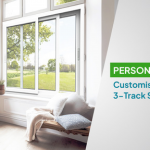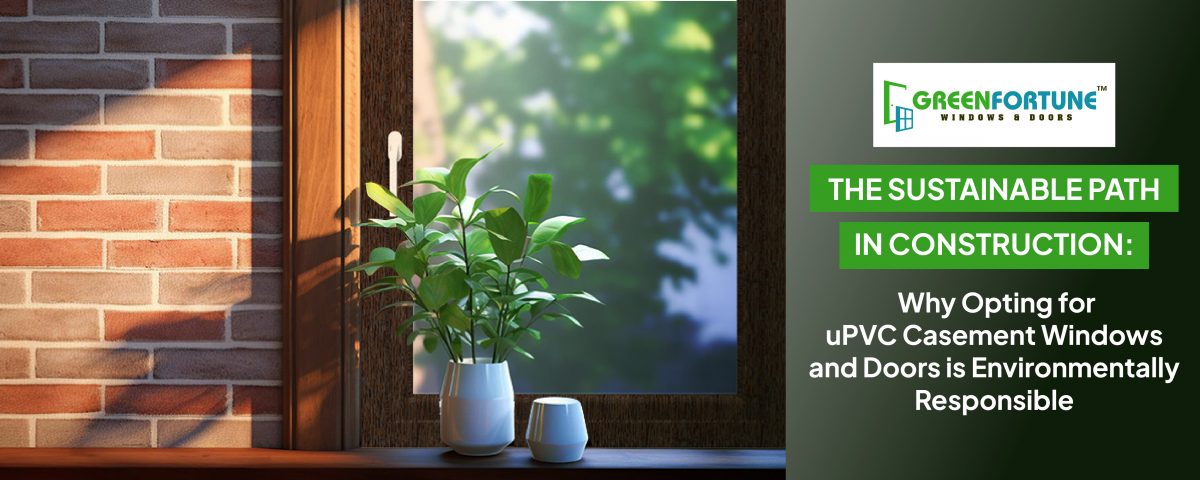
Personalising Your Space: Customisation Options for uPVC 3-Track Sliding Windows
February 12, 2024
Low Maintenance, High Value: The Ease of Upkeeping uPVC Slide Doors
February 15, 2024The Sustainable Path in Construction: Why Opting for uPVC Casement Windows and Doors is Environmentally Responsible
Embarking on a journey through the epochs of construction, each era has woven a distinctive thread into the narrative of our built environment. Our methods and materials have evolved from the architectural marvels of ancient civilisations to the towering achievements of the Industrial Revolution. Fast forward to the present day, and we stand at the threshold of a new era defined by an unprecedented focus on sustainability.
As the detrimental impacts of past practices become increasingly apparent, the construction industry is undergoing a profound transformation. Now, more than ever, sustainability is not just a buzzword but a guiding principle, shaping our approach to design, materials, and construction methodologies. The urgency to build responsibly and minimise our ecological footprint has become paramount. In this era of heightened environmental awareness, the construction industry is not merely erecting structures but pioneering a sustainable legacy that harmonises with present and future needs.
In the domain of construction, sustainability has become a resounding theme – an ethos that envisions crafting spaces in harmony with our planet. Traditional building materials, relied upon for generations, now bear the weight of environmental responsibility, underscoring a pressing challenge.
What is a greener Alternative?
A greener alternative embodies sustainability by minimising environmental impact while serving its intended purpose. Within the construction realm, uPVC casement windows and doors emerge as examples of such alternatives. Far from ordinary fixtures, they are hailed as superheroes catalysing positive change in the industry. Think of them as astute choices actively advancing the welfare of our planet. Unlike conventional building materials that often raise ecological concerns, uPVC doors extend a friendly gesture to Mother Earth. Crafted from eco-conscious materials and designed for recyclability, these doors signify a commitment to a more sustainable future. This endeavour transcends mere door installations; it's a collective endeavour to shape an eco-conscious world, one uPVC door at a time. Are you prepared to embark on this journey where doors evolve into environmental champions? Let's embark on this path together!
The Green Wave in Construction
In the current landscape of construction, a significant wave of change is underway – a green wave that transcends traditional practices and redefines the industry's approach to sustainability.
This surge is not merely a fleeting trend but a paradigm shift towards a more eco-conscious construction ethos. Exploring this green wave involves delving into the broader sustainability trend, where a collective awareness of environmental impact is reshaping how we build our world. The construction industry is witnessing a profound transformation driven by a growing realisation of the ecological consequences of traditional practices.
There is a palpable shift towards embracing eco-friendly materials and practices, marking a departure from conventional choices that often came at the cost of environmental degradation. This evolution emphasises the critical need for green choices in building components, urging stakeholders to consider the environmental impact of every brick laid and every window installed.
As the green wave sweeps through construction practices, it brings to the forefront a demand for innovation, sustainability certifications, and a commitment to reducing carbon footprints. It is no longer just about erecting structures but fostering a holistic and responsible relationship between the built environment and the natural world. This section explores the transformative journey towards sustainability within the construction industry, where the green wave is not only a trend but a conscientious revolution shaping the future of our architectural endeavours.
Understanding uPVC Casement Windows and Doors
In the world of sustainable construction, uPVC casement windows and doors emerge as a distinctive and eco-friendly choice, blending innovation with environmental responsibility. Let's delve into the essentials of uPVC material and the pivotal role of casement windows and doors in fostering sustainability.
1. The Versatility of uPVC Material
uPVC, or unplasticised Polyvinyl Chloride, is highly versatile and sustainable. It possesses unique characteristics that make it an ideal choice for construction. Unlike traditional PVC, uPVC is free from plasticisers, enhancing its durability and resistance to environmental factors. It is known for being low-maintenance, energy-efficient, and recyclable, making it a standout player in pursuing sustainable building solutions.
2. Casement windows and doors: A Sustainable Design Choice
Casement windows and doors, a hallmark of architectural design, play a crucial role in sustainable construction. These doors are hinged at the side and typically swing outward, providing excellent ventilation and natural light. What sets casement windows and doors apart in the realm of sustainability is their ability to enhance energy efficiency. Their design allows for a tight seal when closed, minimising heat loss during colder months and maintaining a cool interior during warmer seasons. This thermal efficiency contributes to reduced energy consumption, aligning perfectly with the principles of eco-conscious building.
Connecting uPVC and Casement windows and doors
Combining the eco-friendly attributes of uPVC material with the sustainable design principles of casement windows and doors results in a harmonious synergy. The durability and energy efficiency of uPVC complements the functionality and environmental benefits of casement windows and doors, creating a winning combination for those seeking both style and sustainability in their construction choices. As we explore the world of uPVC casement windows and doors, it becomes clear that this is more than just a door; it's a gateway to a greener and more energy-efficient architectural future.
Environmental Advantages of uPVC
Embarking on a closer examination of uPVC casement windows and doors unveils a host of environmental advantages that position them as a key player in sustainable construction.
1. Recyclability: A Closed Loop Approach
One notable eco-friendly feature of uPVC casement windows and doors lies in the recyclability of uPVC material. Unlike traditional building materials that end up as long-term environmental burdens, uPVC is recyclable. This closed-loop approach minimises waste and reduces the demand for new raw materials, making it a sustainable choice for those mindful of their environmental impact.
2. Low Energy Production: A Green Manufacturing Process
The manufacturing of uPVC material requires relatively low energy, contributing to a reduced carbon footprint. Compared to alternatives involving energy-intensive processes, uPVC stands out as a more environmentally conscious option. This aspect aligns seamlessly with the broader goal of sustainable construction – to not only build responsibly but to choose materials that reflect a commitment to energy efficiency.
3. Environmental Footprint Reduction
As uPVC casement windows and doors gain prominence in construction projects, they actively contribute to reducing the environmental footprint of these endeavours. The recyclability and energy-efficient manufacturing of uPVC align with sustainable building practices, offering a tangible solution to mitigate the impact of construction on the environment. The adoption of uPVC in construction projects becomes a strategic move towards a more eco-friendly and responsible future.
Energy Efficiency and Thermal Performance
The story of uPVC casement windows and doors extends beyond environmental advantages, delving into energy efficiency and superior thermal performance.
1. Superior Thermal Insulation: Keeping Comfort In and Waste Out
One of the standout features of uPVC casement windows and doors is their superior thermal insulation properties. The design and construction of these doors create a tight seal when closed, minimising heat loss during colder seasons and preventing unwanted heat gain in warmer climates. This inherent thermal efficiency significantly contributes to energy conservation within a building.
2. Aligning with Sustainable Building Standards
Energy-efficient doors, such as uPVC casement windows and doors, go hand in hand with sustainable building standards. They contribute to achieving certifications like LEED (Leadership in Energy and Environmental Design) and other green building standards. The emphasis on energy efficiency aligns with environmental responsibility and positions uPVC casement windows and doors as a practical choice for those aiming to meet or exceed stringent sustainability criteria in their construction projects.
In the synergy of environmental advantages, energy efficiency, and thermal performance, uPVC casement windows and doors emerge as a beacon of sustainability, inviting us to reconsider how we build and how responsibly we choose our building components.
Paving the Green Path Forward with GreenFortune
As our exploration of the environmental advantages, energy efficiency, and thermal performance of uPVC casement windows and doors comes to a close, GreenFortune emerges as a beacon in the sustainability narrative. These doors, meticulously crafted from eco-friendly uPVC material, transcend their role as mere architectural elements, evolving into catalysts for a greener and more sustainable future in construction.
GreenFortune, as the provider of cutting-edge uPVC doors and window solutions, ensures that each installation contributes to a closed-loop approach. The recyclability and low-energy manufacturing of uPVC underscore GreenFortune's commitment to environmental stewardship. Builders and homeowners, by choosing GreenFortune's uPVC casement windows and doors, actively participate in reducing waste and embracing a more sustainable lifecycle for construction materials.
Furthermore, the superior thermal insulation properties of GreenFortune's uPVC casement windows and doors showcase their pivotal role in enhancing energy efficiency within buildings. These doors are guardians, adept at keeping comfort in and wasting out. The seamless synergy between energy efficiency and thermal performance aligns with the highest sustainable building standards and positions GreenFortune's uPVC casement windows and doors as integral components in constructing environmentally responsible and resilient structures.
GreenFortune's uPVC casement windows and doors transcend their functional role as mere entryways in the journey towards sustainable construction. They embody a conscious choice for those envisioning a built environment harmonising with the natural world. As we progress forward, let GreenFortune's doors serve not just as functional elements but as symbols of responsible building practices, reminding us that every choice in construction, especially when guided by companies like GreenFortune, holds the power to shape a greener, more sustainable future for generations to come.
FAQs
Q1: What is a uPVC casement window?
A: A uPVC casement window is a window made from unplasticised polyvinyl chloride (uPVC) that swings open like a door, providing excellent ventilation, durability, and low maintenance.
Q2: What exactly is uPVC?
A: uPVC stands for unplasticised polyvinyl chloride, a rigid, weather-resistant material used in windows and doors for strength, energy efficiency, and long-lasting performance.
Q3: What are uPVC doors and windows?
A: uPVC doors and windows are made from durable, low-maintenance uPVC material, offering thermal insulation, security, and modern design options for homes and commercial spaces.
Q4: Where can I find uPVC casement windows and doors near me?
A: If you’re searching for uPVC casement windows and doors in Hyderabad or Telangana, GreenFortune showrooms in Hyderabad and across Telangana state provide a variety of designs, expert guidance, and on-site demonstrations to help you choose the right products.
Q5: What is the price of uPVC casement windows and doors?
A: The price of uPVC casement windows and doors depends on size, design, and additional features like mosquito mesh. GreenFortune provides customised, transparent quotes to suit your home and budget.







